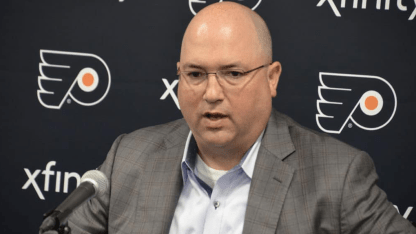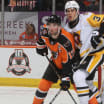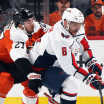As with all of society, the COVID-19 pandemic has wreaked havoc with the hockey world. One of the prime areas affected was the 2020 NHL Draft,which has been moved back from June 26-27 to October 6-7. Originally slated to be held in person at the Bell Centre in Montreal, the Draft will now be a virtual event held remotely from the NHL Network studios in Secaucus, New Jersey.
Flahr: "We're Confident We'll Get the Draft Right"

For the young hockey players awaiting Draft selection, as well as for their families, the wait has spilled over from the offseason to what would typically be the next offseason. For the NHL teams, this year's preparations have been unlike those of any "normal" year, at least from March onward.
While the National Hockey League was eventually able to see through a return-to-play plan to conduct the 2020 Stanley Cup Playoffs, most other professional and amateur hockey leagues were forced to cancel their stretch drives and/or postseasons. There were no CHL or USHL league playoffs, no Memorial Cup, no NCAA Frozen Four, no European pro or junior league playoffs, no IIHF Under-18 World Championships and no IIHF men's World Championships.
Moreover, the pandemic caused the cancelation of the 2020 NHL Draft Combine; both the physical testing and the in-person interview opportunities for players and team staff. NHL teams also had to work around the gathering of medical information on Draft candidates.
Despite these complications, which equally affected the pre-Draft preparations of every team in the NHL, Flyers assistant general manager and team vice president Brent Flahr feels the organization will look back at the 2020 Draft in the long-term future as a successful one in advancing the club's fortunes at the NHL level.
On Sept.25, Flahr spoke remotely with PhiladelphiaFlyers.com's Bill Meltzer and Flyers Daily host Jason Myrtetus to discuss the unusual preparations that went into this year's Draft. He also talked about the depth of talent available in the 2020 Draft.
"It's certainly different. it's odd. You know, we have guys all over the world. And we have good staff, which is, which is beneficial for us. But at the same time, you don't get to see the under 18 tournament, the end of the year, which is usually the combination of you see all the top players against each other don't have the Combine to see where they are physically, athletically and, and whatnot, which is a challenge. But so we have to do our best," Flahr said.
"Our amateur guys have all talked to these players individually, whether via Zoom or over the phone. We talk to trainers, do all the background we can and assume they're being honest. That's all we can do. And that's all the other teams can do as well. So it's a challenge, for sure. At the same time, we're confident we'll get it right."
In terms of talent sources, Flahr believes the talent pool depth this year is a bit better in the Canadian major junior (CHL) leagues than it was in some recent Draft years. Simultaneously, there was a fully expected downward correction after last year's record-setting crop of Draft talent from the U.S. National Team Development Program, which saw a jaw-dropping 17 players selected including Flyers 2019 first-round pick Cam York and second-rounder Bobby Brink. Over in Europe, the 2020 Draft is also not as deep at the top end and some recent Draft years.
That's not to say there's a lack of quality prospects across Europe and North America, including other familiar U.S. based Draft-feeding leagues such as the USHL and the collegiate ranks. There are just fewer slam-dunk prospects whose post-Draft development timetables for possible NHL readiness can already be projected with an elevated degree of certainty.
"Obviously, [Alexis Lafreniere] is number one, like everybody knows. Then after that, I think there are a couple guys in the next range and then probably the next 11 or 12 this year. I think it's gonna be interesting. There's a lot of good, really good players, different positions, different styles, whether it's a scorer, D-man, centerman, skill player, goalie, whatever. there's a number of top end players then a drop off a little bit," Flahr said.
"There's a grouping from there, probably [top] 25 or so, that could go in lots of different directions. We're picking 23. I think we'll get a player that's higher up on our list is my guess, the way it usually works. It'll be interesting to see how it falls."
MORE USE OF VIDEO SCOUTING AND ANALYTICS DATA
During the worldwide pauses/cancelations of the latter part of the 2019-20 hockey seasons, the Flyers and other NHL organizations made use of the time to do some added video studio and statistical analysis as pieces of the puzzle in creating their internal rankings. These steps are not considered an equal substitute for live scouting -- in a live viewing, a scout better sees the whole ice as plays develop, whereas video can have limitations -- and do not carry quite the same weight as live viewings. Nonetheless, extensive video study is useful as supplementary information.
"I've been spending the last three or four days, and beyond, and it's just been all video. But in the last six months, for all these guys, we have been watching a lot of video. Some of it is dangerous, I think a little bit. just because, video is what it is. But at the same time, you get to know some of these players better and confirm some of the things you think or then sometimes it makes you change your mind, if you see different things in games. The good thing is we get to see lots of games, you see players over patterns. You also use your analytics staff. We got a lot of input. We've had a lot of time to dig deep on a lot of these players," Flahr said.
SOME 2020-21 SEASONS HAVE ALREADY STARTED
One of the more intriguing twists to the delayed 2020 NHL Draft is that this year's Draft has spilled over into the 2020-21 season. Regular seasons in Europe are now underway (although some leagues have had COVID-related game postponements), while North American leagues have significantly staggered starts from one another.
The Flyers, like all NHL teams, have to weigh whether to tweak their internal rankings -- and, if so, by how much -- based on what they've learned about players' progress over the last six-and-a-half months since the final live-scouting opportunities from last season.
"You've got players in Europe that have started. Guys in the Quebec League are starting to get fresh viewings. Some guys are off to a hot start. Some guys are slow off the mark, and you got to really manage those details as well. You're not going to you, or you shouldn't, penalize a player because he's not playing yet. So we're going to weigh those details, but. at the same time, the more information to get. the better," Flahr said.
Because only a fraction of Draft-eligible players have already had their frames fill out fully to close to what their physical profiles will be at the pro levels, the extended gap from the end of last season and the absence of a Draft Combine this year has created extra legwork for NHL team scouting staffs. The six-and-a-half month gap is something that must be considered in final pre-Draft preparations.
Each year, there are a handful of players who have late growth spurts or who add muscle during the offseason. How did prospects address their conditioning during lengthy quarantine periods? Who had access to ice, and when?
MOST CONSIDERATIONS ARE TIMELESS
The Flyers drafting philosophy under Chuck Fletcher and Flahr is fundamentally similar to what it was during the years under Ron Hextall and Chris Pryor. In the first round team will take the best available player (i.e., the highest still-available player on their internal rankings). regardless of the position he plays. Organizational depth needs by position figure in to a wider degree later in the Draft.
At some point in most Draft years, many teams aim to take at least one goaltender. Goalie prospects are the most unpredictable of any position which is why many organizations nowadays shy away from selecting a goalie in the first or second round unless he is so advanced in both his game and his physical makeup that it's a reasonably safe and high upside pick.
Sometimes a team can hit a home run with an early selection of a goalie. The Flyers' second-round selection of Carter Hart in 2016 as the first goaltender off the board has certainly paid off so far. Such prospects do not come along every year, however.
"Chuck's always been a believer in as well as, try to draft the goalie almost every year. You don't have to draft him early rounds. A lot of these guys take time, whether it's four, five, or six years. You draft them early, and then all of a sudden, the patience is gone [because] you want them to play right away. But you look at a lot of the goalies that are taken in the first round. There are exceptions, like Carey Price or Andrei Vasilevskiy. But they need time to develop, to learn to play, and learn to deal with the workload in the NHL. Not all guys can make it," Flahr said.
"You know, you're mentally redrafting young players, and you see the talent level of these guys and their ability. You're trying to project them to be NHL players. The mental toughness that you need to play goaltender in the NHL is is huge, and that's developed as well. And not everybody has it, which is harder to detect as a as an 18 year old. There's less [pressure] when you're getting a little deeper into the draft "
When doing final rankings, the Flyers (and most organizations) seek consensus among their scouts on potential picks. Consensus quite often rules the day at the Draft. If there's a wide and vehement discrepancy of opinions among the scouts on a particular Draft candidate, that can also factor in why one prospect is less favored as a selection possibility over another. When all is said and done, though,the general manager makes the final decision.
Along with staff consensus, the final recommendation of the assistant general manager also typically weighs heavily in the GM's selection decision. In most cases, the AGM has more extensive direct scouting knowledge at the ready on each potential pick.
Each and every Draft year, NHL staffs weigh the same sorts of questions when determining final rankings:
* If the prospect's primary allure is his pure offensive skills, does he project to score enough at the NHL level to play in a top-six role with power play time? Does his game eventually project as sufficiently well-rounded to be effective if he ends up scoring less frequently than hoped? If a player is likely to score at a prolific rate as a pro, other shortcoming can be overlooked to a degree. However, such players are hard to find and even they will be expected to improve their off-puck games over time.
* Among the coveted "4S" tools -- skill, size, speed, and smarts -- which does the player possess and which does he lack? Hockey sense and hands are things that cannot be taught. Other things can be improved through coaching and work ethic, or at least worked around by a savvy player (such as an undersized player who is nonetheless able to win puck battles with consistency or a player who lacks blazing speed but compensates by good reads and taking the shortest routes). If these areas are not currently strengths, how much added conditioning, muscle, skating refinement and/or defensive improvement is needed in the development cycle?
* Are there any character or coachability red flags? Is it simply a natural maturation process? Could it just be a case of a player who doesn't interview as another Draft candidate but will be fine over time?
* Is the player "locked" into a certain role or position? Is he versatile enough to adapt to filling a team need once he becomes pro? If he's a center at his current level, could he play wing instead as a pro? Is he a candidate to play in all game situations, including both ends of special teams? It is more common for centers to be converted later into wingers than the other way around (although there are exceptions).
Another consideration that comes up every year: How should a team account in its final rankings for late-year birthdays? First-time eligible players this year were born anywhere from September 16, 2001 to September 15, 2002. Players who barely missed the eligibility cutoff for one Draft year become the oldest first-time eligible candidates the next year. Flahr said that being a late-birth year player can affect a ranking "a little bit," but it should not be a primary factor.
"It's not their fault. You can't penalize them for when they're born. At the same time, you have to realize that they're a little older and potentially played an extra [pre-Draft] year in junior. So they should be more dynamic or, or more productive in their Draft year. But, yeah, it's something that you do take into account and you basically double check. And some scouts are biased about that. You have to basically correct them. and, you know, make sure they're keeping an open mind."
For example, in the 2020 Draft class, Ottawa 67's right winger Jack Quinn was born on Sept. 19, 2001. Had he been born even four days earlier, Quinn would have been eligible for the 2019 Draft. He is only a few weeks or a couple months younger than several players who were early-round selections last June. By comparison, there's a host of 2020 Draft candidates born during the 2002 calendar year, including some who were born shortly before the birthdate cutoff for this year's Draft.
A Flyers example: center Nolan Patrick was born on Sept. 19, 1998. Had he been born four days earlier, he'd have been eligible for the 2016 NHL Draft (and a likely upper first-round pick even then). Instead, he became eligible for the first time in the 2017 Draft when the Flyers took him second overall. Morgan Frost, selected by the Flyers with their latter first-round pick in the same Draft is nearly eight months younger than Patrick. Frost was born on May 14, 1999.
A FAMILY AFFAIR
Every once in a while, a potentially awkward situation arises where a Draft prospective is a relative of a member of an organization's scouting or coaching staff.
In the 2018 NHL Draft, the Flyers had two first round picks. Western Michigan University bound USNTDP defenseman Mattias Samuelsson -- a Voorhees native and the son of current Flyers development coach and longtime player Kjell Samuelsson was a candidate for selection anywhere from the middle of the first round to early in the second round. The Flyers opted to use their latter first-round pick on forward Jay O'Brien. Samuelsson was ultimately selected by the Buffalo Sabres with the first pick of the second round.
There's a similar situation this year, where Brandon Wheat Kings forward Ridly Greig is widely projected to be selected in the latter half of the first round to early in the second. He is the son of longtime current Flyers Western Canada-based scout and former Flyers/Phantoms player Mark Greig.
As is usually the case in such situations, the elder Greig prefers that another team select his son. This would allow Ridly to develop on his own with no added pressure or scrutiny of the selection based primarily on his last name and family ties. Flahr understands the sentiment but cannot promise how the first round will play out.
"It's been a challenge. He's really a great kid, and we all know him. Mark was adamant coming into the year, and even most of the year, 'I don't want the Flyers drafting him. I don't want our guys doing reports on him.' It's not that he doesn't want to be a Flyer. He was a Flyers fan growing up, and Claude Giroux is his favorite player. It's more the backlack if we drafted him, the media [stories], and [potential criticism as] nepotism. I get that to a degree but my point to him recently is that we'll draft him if he's the best player on the Draft board at the time," Flahr said.
"It's a dynamic that fans and media don't really think about. He's [rated] in a range where he could be gone where we pick, which might be a blessing for Greiger's stress level. But at the same time, he's a kid everybody likes. He's not the biggest body but he's a competitive kid. He skates well. He plays an honest game, he scores and he's got some grit. ....Obviously, Greiger's stress levels are off the wall and he's a proud father. You know, reality is that [teammate and fellow 2020 Draft candidate] Braden Schneider is there, too. So, you know, Brandon was a heavily, heavily scouted team this year."
Ridly Greig is one of several relatives of Flyers Alumni who are available for this year's Draft. Others include another potential first-round pick in big-framed Spokane Chiefs center Jack Finley (son of 1990s Flyers alum defenseman Jeff Finley), Växjö Lakers wing prospect Eric Juhlin (son of mid-90s Flyer/Phantom and 1994 Olympics standout Patrik Juhlin), UNH-committed forward David Sacco (nephew of Flyers alum forward and longtime NHL coach Joe Sacco, son of former NHL forward Dave Sacco) and Modo junior defenseman Hugo Styf (son of former Flyers draftee Pär Styf). However, among this group, only Greig's father is currently employed by the Flyers' organization.


















